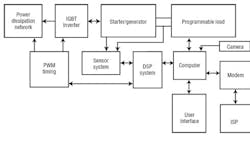A group of engineers consisting of mechanical, electronic, and software specialists are in the process of making history. They have united to perfect a digitally controlled 8-kW induction motor that will serve as both a starter and generator in a not-too-distant model year car.
What makes their research so extraordinary is neither the application nor the motor technology — though both are leading edge — but the fact that all of the team members are working remotely over the Internet, interactively conducting tests, analyzing data, and making design modifications. The software experts are in Rhode Island, while the automotive engineers work from their home base in Detroit. The test stand, consisting of the motor and an IGBT-switched programmable load, is also in R.I.
Futurists have speculated for several years about using the Internet to project a virtual presence into a working laboratory, but software developers are only now delivering on less ambitious promises like remote computer simulation, data retrieval, and teleconferencing. Nevertheless, the dream of fully interactive remote control across several pieces of hardware is becoming a reality.
Log on lab
The Internet as a collaborative research environment is just the thing for today’s increasingly complex global society. Multinational corporations may make sense from a marketing perspective, but they present a challenge when it comes to maintaining the pace of technological development.
Tomorrow’s cars, machine tools, and medical systems require the best efforts of the most experienced cross-disciplinary engineering teams we can muster. Problem is, within most organizations, the people with complementary skill sets are not all on the same site. By bringing coworkers together, remote Internet technology not only reduces the cost of travel, but also leverages equipment availability, saves time, and compresses iteration cycles.
Although the interactive experimentation platform used is tailored for an automotive application, all you’d have to do is change a few components to reconfigure it. In theory, it represents any electromechanical, electronic, or power system. Here, however, the goal is to design a compact ultra-efficient starter/generator using a three-phase 12-pole induction motor.
The DSP-based system that drives the motor uses indirect vector-current and velocity control. It also supplies pulse width modulation (PWM) timing for both the motor and programmable load.
Ordinarily, it would be difficult to run a highly tuned system like this from afar, but an adaptive element, an outer-loop fuzzy logic controller, keeps everything under control. The fuzzy controller tunes the system for optimum efficiency at any user-specified operating point.
Users in different parts of the country enter commands through graphical interfaces running on standard Web browsers. From their screens, they can monitor the experiment’s progress, displaying measured data in real-time. They also have access to stored data for offline analysis.
The energy that the motor generates is dissipated in an IGBT-switched resistorbraking network. Dc bus voltage (for the inverter) is maintained between 300 and 350 V by a hysteretic voltage controller implemented in the DSP. Having a programmable load means users can generate active load profiles, even on the fly, to emulate various load and road conditions.
A sensor network conditions and samples current, voltage, speed, and power. It also measures the efficiency of any component or combination of components.
The Internet connection is made through a dialup modem on a local area network. No special communication facilities are involved, just a commercial Internet service provider.
Run time
As velocity is periodically changed to create new operating points, the role of the fuzzy logic controller becomes apparent. Sudden changes in velocity or torque have an immediate effect on efficiency, causing it to drop sharply. But the adaptive nature of fuzzy logic quickly re-tunes the system, causing efficiency to rebound.
After all connections have been established, users may operate the motor and load from any location. A simple graphical panel serves as the interface. Other panels display sensor signals and information associated with the fuzzy mapping function.
Efficiency measurements are communicated back to the remote site and automatically entered into a table. In this way, user-specific, optimum efficiency contours can be remotely mapped. Many people can make changes at once and immediately see the effect on efficiency, which is the key to team-oriented, remote, interactive development.
Collaborative efficiency experiments conducted over the Internet so far have linked several cities, including Detroit, St. Louis, Phoenix, and Cranston, R.I., the site of the motor test platform. The test setup itself is shown on the previous page with an image from a remote video display (inset) as transmitted over the Web.
Efficiency plots for the fuzzy controlled starter/generator are also shown. They reveal that motor efficiency peaks at about 1,400 rpm. From their tests, the engineers also know to avoid low speeds (below 400 rpm) because it wastes precious battery energy.
Raymond B. Sepe Jr., Ph.D., is vice president of research and development services for Electro Standards Laboratories, Cranston, R.I. Special thanks to John Miller and Allan Gale of Ford Motor Co. for their support with the fuzzy logic optimizing control software.
